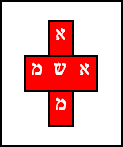| |
The Scrabble Factor
The seven Hanukah ELSs appear within a 1,123 letter long section of text, which is somewhat smaller than the 1,584 letter long section that is crossed by all of the Isaiah 53 ELSs that are at least as significant as the Hanukah finds. So the two source texts are fairly comparable in size. In reality most of the Isaiah 53 cluster is concentrated in the last half of the 1,584 letter long section. For example, 57 of the 85 most improbable ELSs cross this latter section of text, which is only 700 letters long.
A comparison of the sheer number of ELSs is only part of the story, however. What also counts is how likely or unlikely each ELS is to cross a section of text. The longer an ELS is, the more unlikely it is to appear by chance. And the shorter the skips between its letters, the more unlikely it is to show up coincidentally. Finally, whether the letters of the ELS are fairly common or uncommon also affects the chances it could just appear.
Just as in Scrabble, where it is hard to compose a word with a Q or an X, so there are little used letters in Hebrew. And, as in Scrabble, where it is much harder to use all seven letters when composing a word, so seven-letter ELSs are much less common than three or four-letter ELSs. We have taken all these factors precisely into account in determining what the odds are that each ELS in both clusters could cross a randomly selected section of text that is exactly 1,000 letters long. They are presented below, with the most improbable ELSs shown first.
As you can see, there are dozens of ELSs from the Isaiah 53 cluster that are each less likely to appear by chance than the most likely Hanukah ELS. What is immediately evident is that none of the Hanukah ELSs are all that unusual. On the other hand, there are four Isaiah 53 ELSs that each have odds less than 1 in 1 million of crossing a randomly selected 1,000-letter long text. None of the Hanukah ELSs are anywhere near as unusual as the top ranked Isaiah 53 ELSs. The most unlikely Hanukah ELS has odds of 1 in 453 of appearing by chance.

|
By way of comparison, for the original "Yeshua is my name" ELS that Rambsel found with a skip of 40 or less, the odds that it will cross any randomly selected 1,000 letter long section from the Tanach, are 1 in 1,060. This makes it somewhat more improbable than the most improbable ELS in the Hanukah cluster.
Excess Occurrences of the Mary ELS
There are two unusual code entries in the above table. One entry in the purple section of the table states, "Mary ELS Appears 16 Times (Vs. 4.76 Expected By Chance)." We had looked for occurrences of the Hebrew word for Mary (Miriam) within Isaiah 52:12-54:3. While this short ELS was expected to show up 4.76 times within the text with skips of 1-50, it actually appeared 16 times. The odds of this occurring were less than 1 in 25,368, as shown in the above chart.
To check this startling result, we scrambled the letters of Miriam and looked for each of these possible rearrangements as an ELS. None of the alternative "words" appear an unusual number of times. There really is no comparison. All of these other results fell well within the bell-shaped curve describing the number of times we would expect that the ELS would show up. On the other hand, the number of Mary ELSs was way off the charts, far to the right of the bell-shaped curve.
Excess Occurrences of Prophecy/Guilt Offering ELS Crosses
An ELS Cross occurs when the ELS appears with a short skip (such as 5 or less), and its middle letter coincides with the middle letter of another ELS of the same word with a longer skip (e.g., up to 100). What follows is an example using the Hebrew word, A-Shem, OZA, or Alef-Sheen-Mem.
|

|
In this example the horizontal beam of the cross is made up of an appearance of the ELS with a skip of +1, while the vertical beam is made up of another ELS of the same word, with a skip of, say 48.
In Isaiah 52:11-53:12, we would expect 3.6 of these visual crosses to appear by chance. Instead, there are 21 of them. The odds of this just happening are 1 in 3.2 billion. This extraordinary excess of visual crosses is not due to one or more words or phrases appearing in the literal passage several times (and that contains the ELS within it). What makes it unusually pertinent are the meanings of the word. A-Shem means "guilt" in contemporary and Biblical Hebrew, but it also is a short form for "guilt offering" in various passages in the Hebrew Bible. Spelled backwards, the same ELS means "prophecy" or "burden." What is Isaiah 53 about? It is a prophecy of a guilt offering. What could be a more succinct and appropriate summary of the literal passage than this little three-letter word. And to have it cross itself 21 times in forming visual crosses would seem to be a form of intentional repetition that stresses the importance of the theme of the passage.
There is much more, however. We have devoted an entire section of this report to detailing the manner in which these crosses appear, often lying right on top of one another, and often appearing very close to many of the most significant codes in the passage. These facets underscore the only reasonable explanation for this phenomena: intentional placement. Click here for more detailed information on this unique phenomenon.
Dealing With "Wiggle Room"
As shown above, the odds of finding a cluster similar to the Hanukah example are less than 1 in 5, indicating quite clearly that it could be very easily due to chance. On the other hand, the odds of finding a cluster similar to the Isaiah 53 example are so astronomically remote as to completely rule out chance as a rational explanation.
The Isaiah 53 odds are so small that skeptics will immediately suspect that they have not been adjusted for "wiggle room." Nothing could be further from the truth. We have factored in the effects of "wiggle room" far beyond what is in any way reasonable, so there can be no doubt left that the Isaiah 53 cluster is real.
The above odds against a cluster similar to the Isaiah 53 one appearing by chance reflect the possibility that either the above cluster, or any one of 437,200,000,000,000,000,000,000,000,
000,000,000,000,000,000,000,000,000,000,000,000,000,000,000,000,000,000,000,000,000,
000,000,000,000,000,000,000,000,000,000,000,000,000,000,000,000,000,000,000,000,000,
000,000,000,000,000,000,000,000,000,000,000,000,000,000,000,000,000,000,000,000,000,
000,000,000,000,000,000,000,000,000,000,000,000,000,000,000,000,000,000,000,000,000,
000,000,000,000,000,000,000,000,000,000,000,000,000,000,000,000,000,000,000,000,000,
000,000,000,000,000,000,000,000,000,000,000,000,000,000,000,000,000,000,000,000,000
similar clusters, could appear by chance. Before we reflected this, the unadjusted probability
of the exact cluster described above of appearing by chance was so remote that the Excel spreadsheet program could not calculate it. The adjusted probability is 2.3 followed by 212 zeroes.
Now any method of estimating the odds of these configurations happening by chance is bound to be very complicated, and that makes it easy for an opposing expert to claim that we should have done our calculations at least a bit differently than we have. After all, how is the average man on the street going to decide which expert is right? So, rather than getting bogged down in math, we would point out that the simple dictates of common sense also lead to the same conclusion -- the Isaiah 53 cluster is far too dense and extensive to be explained by chance.
It only makes sense that you could find a few shorter terms about many subjects in the text of any book. What makes no sense whatsoever is that you could find such an overwhelming collection of topically related ELSs congregating within a few pages of text. While the chance re-acquaintance of two long lost friends may be a coincidence we all know happens, when dozens of long lost friends all happen to bump into one another at the same place on the same day, common sense tells us that the reunion was planned. When too many coincidences congregate together, we know it could not be a coincidence.
Going Above and Beyond
Even though we have carefully catalogued about 100 ELSs about Christ as the only ones that we looked for and did not find in Isaiah 53, we should state we started by including the ELSs that Rambsel and Jeffrey located. We do not know how many different ELSs they looked for and did not find.
Furthermore, distrust is high among skeptics. So we went far beyond what is reasonable in adjusting our calculations. In calculating the above odds, we assumed that for every word we did find as an ELS that we (or Rambsel/Jeffrey) actually had to look for 25 different comparable ELSs before we found the one we documented. That means that our probability calculation reflects the effects of looking for 10,000 different words about Christ in order to find the 400 distinct words we did locate as ELSs. The point is that there aren't that many different Hebrew words about the topic of Jesus of Nazareth. That is why we can conclude the odds of chance appearance are LESS THAN the 1 in 225,900,000,000,000,000,000,000,000,000,000,
000,000,000,000,000,000,000,000,000,000,000,000,000,000,000,000,000,000,000,000,000,
000,000,000,000,000,000,000,000,000,000,000,000,000,000,000,000,000,000,000,000,000,
000,000,000,000,000,000,000,000,000,000,000,000,000,000,000,000,000,000 quoted in the above chart, and that the Isaiah 53 cluster was intentionally embedded in the text.
And while we assumed that there were at most 10,000 different words that could be considered to be relevant to the topic of Jesus Christ in adjusting for the maximum effects of "wiggle room" in the Isaiah 53 odds calculation, we only assumed there were at most 1,000 different words that could be considered to be relevant to the topic of Hanukah. If we had made the same assumption for Hanukah as we did for Isaiah 53, the odds of chance occurrence of the Hanukah example would rise to be "less than 100%."
CLICK HERE to go to the next page or on a link below to continue:
- Comparing Clusters First of all, how does the Hanukah cluster compare to a truly significant example such as the Isaiah 53 cluster? And what do they look like when shown as matrices?
- Comparing ELSs Just take a look at the huge number of ELSs in the Isaiah 53 cluster compared with the seven valid Hanukah ELSs.
- Odds See the truly astonishing odds that codes from both sources would appear where they do by chance.
- Compactness How close are these codes to each other? We compared the remarkable compactness of the Isaiah 53 cluster with the War and Peace cluster.
- In Hebrew We also did a very illuminating side-by-side comparison between the Hebrew spellings of words in each cluster.
- Curiosities There are some other very unusual aspects of the Isaiah 53 cluster, including mind-boggling word patterns far more intricate and extensive than the Hanukah codes.
- Meanings We've also shown explanations of the Isaiah 53 terms in the cluster.
- Anticipating Skeptics And finally, we've tried to anticipate how the skeptics might respond to this report.
|
|







Click here
and sign up to receive Bible Code Digest with no cost or obligation.
 Code Skeptics' Arguments Trashed Ever since the first Bible codes were announced, skeptics have been saying, "Oh, well, you can also find codes like that in books like War and Peace and Moby Dick."
We took the time to examine this notion and the best example of it that the skeptics have been able to come up with. The results of our research have completely blown away their theory.
Click here to see for yourself.
NEW: Second Study Undermines
Skeptics' Main Objection
to Codes
Click here for report |











